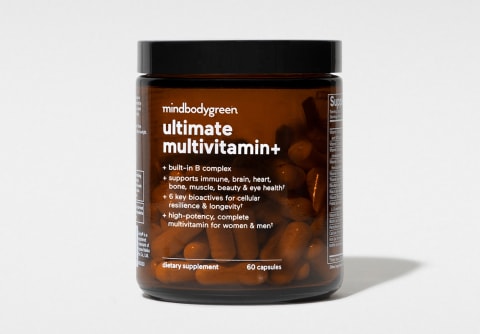Advertisement
3 Hacks To Get Your Brain To Love Exercise, From A Neuroscientist


Look, we've all been there: You're familiar with the benefits of regular exercise, you pencil in time for a workout, maybe you even have your sneakers all laced up and ready to go—and yet, you just can't get yourself to head out the door. You may tell yourself the couch is too comfortable; that new Netflix series is calling your name; or the oft-repeated promise, I'll start tomorrow.
Neuroscientist and associate professor of kinesiology Jennifer Heisz, Ph.D., author of Move the Body, Heal the Mind, is well aware of this internal dilemma. In fact, she says it's a pretty common mindset for those starting a new workout routine. "The reality is that exercising is hard. It's a physical stressor that activates the body," she says on this episode of the mindbodygreen podcast. "And the brain wants to keep the body in a homeostatic, happy place. So you're working against these two inherent opposing forces."
However, Heisz notes there are some hacks that can convince your brain to love working out, even before those exercise endorphins make their appearance. Below, find her go-to tricks:
Listen to music before you exercise.
Sure, you might toss on an energizing playlist on a run or walk, but according to Heisz, listening to your favorite tunes just before heading out the door can inspire you to get moving. "It can stimulate the reward system and start making that connection with movement and enjoyment," she explains. In fact, research has found that upbeat music increased participant motivation for high-intensity workouts1.
See, if you're starting a new exercise routine, your brain isn't familiar with the sense of enjoyment you may receive after the fact (thanks to those feel-good endorphins). Over time, your brain might connect exercise with a positive experience, but right now, your brain wants you to stay comfortable and relaxed—which is why you may face a lack of motivation. "Listening to your favorite music can bootstrap that process," says Heisz.
Swish-and-spit technique.
"Another trick is the swish-and-spit," Heisz shares. "Basically, there's some research showing that if you take a swish of a sugary drink in your mouth, it's easier for you to be active." The study, documented in the journal Human Kinetics, found that when runners swish sugar water in their mouths (without swallowing), they had increased endurance and faster running times.
"The idea is that it convinces the lazy brain that resources are plenty," says Heisz. "But the trick is you don't actually have to drink it—you can just swish it around in your mouth and that's enough." Just one final caveat: Artificial sweeteners don't have the same effect, according to the study. "It has to be real sugar," Heisz adds.
Fear-buster workout.
While the above tips are more general workout hacks, this technique is especially helpful for those who struggle with feelings of anxiousness. A lot of people who struggle with this also struggle with the sensitivity of feelings associated with worry or panic, she explains, "like a racing heart and difficulty breathing." Those sensations are similar to how you might feel during vigorous exercise, so your brain might subconsciously fear those high-intensity workouts.
In this case, Heisz recommends a technique called the "fear-buster workout," which includes a light to moderate walk with a very short sprint at the end. Why does this work? Well, that light to moderate exercise increases a brain-resilience factor called neuropeptide Y2. "It's a protective factor from the damaging effects of stress," says Heisz.
After you build up that neuropeptide Y, the theory is that your brain becomes more resilient to tolerate that short sprint at the end. The intense burst of exercise, "essentially acts like an exposure therapy," Heisz explains. "They're getting used to feeling their heart race and that difficulty breathing, but it's in this safe space where their brain is infused with resiliency, and it seems OK. Exposing themselves to these intense feelings, watching them come and go, and realizing they're safe is really therapeutic."
The takeaway.
The hardest part about starting a new exercise routine is actually, well, starting—from there, your brain will gradually associate those happy endorphins with the workout itself. Try Heisz's workout hacks to motivate your brain and body in the beginning, then browse our library of at-home routines to find one you love.
If you are pregnant, breastfeeding, or taking medications, consult with your doctor before starting a supplement routine. It is always optimal to consult with a health care provider when considering what supplements are right for you.
Watch Next
Enjoy some of our favorite clips from classes
Enjoy some of our favorite clips from classes
What Is Meditation?
Mindfulness/Spirituality | Light Watkins
Box Breathing
Mindfulness/Spirituality | Gwen Dittmar
What Breathwork Can Address
Mindfulness/Spirituality | Gwen Dittmar
The 8 Limbs of Yoga - What is Asana?
Yoga | Caley Alyssa
Two Standing Postures to Open Up Tight Hips
Yoga | Caley Alyssa
How Plants Can Optimize Athletic Performance
Nutrition | Rich Roll
What to Eat Before a Workout
Nutrition | Rich Roll
How Ayurveda Helps Us Navigate Modern Life
Nutrition | Sahara Rose
Messages About Love & Relationships
Love & Relationships | Esther Perel
Love Languages
Love & Relationships | Esther Perel


















